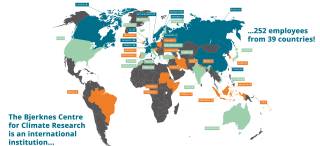By Tore Furevik, Director of the BCCR
The Bjerknes Centre for Climate Research was established in June 2000, named after father and son Vilhelm and Jacob Bjerknes, who were true visionaries and pioneers in meteorology and climate.
Climate scientists from the University of Bergen, the Institute of Marine Research, and the Nansen Environmental and Remote Sensing Center joined forces to create common strategies, assemble new research groups, and develop projects under a strong branding.
Twenty years later, we are four partners, as NORCE has become a crucial climate research institution in Bergen.
This early effort, championed by Eystein Jansen, led to a successful bid to become one of the first ten Norwegian Centres of Excellence. This new programme launched by the Norwegian Research Council provided generous funding from 2003 to 2012. After only a few years of operation, the Bjerknes Centre for Climate Research became a well-known international institution and its mid-term evaluation concluded that the centre had produced outstanding research results and is at the forefront of develop- ments in our field. A key to success has been the integration of the expertise represented by the four partners, and continued dedication to this unique science cluster has been vital to its development.
From the very beginning, the Bjerknes Centre has had a strong focus on societal relevance, and since its infancy provided society with valuable insights through cutting-edge research and through our engagement in public debates on climate. In 2010, the Stoltenberg government decided to give us a 12-year grant through the Ministry of Education and Research. An international evaluation conducted in late 2017 concluded that the investment has been a wise one, and that the committee recommends continuance of funding. As we approach the end of the 12-year funding period, it is worthwhile to reflect on where we are today.
The Bjerknes Centre currently includes more than 250 people from 39 nations; it ranks among the largest climate research communities in Europe in terms of size, interdisciplinarity, production, and visibility. We publish, on average, five scientific papers per week and are cited in 180 others. Bjerknes publication number 2000 is just around the corner.
We publish in high-ranked journals and often provide background materials for national and interannual synthesis reports and policy briefings.
Apart from providing a steady flow of scientific papers we’re devoted to research training and education. Since 2009 we have coordinated the national research schools in climate, as well as a number of international partnership programmes involving summer schools and student mobility. The Advanced Climate Dynamics Coursers (ACDC) has become an internationally acclaimed summer school, with the 11th in a row taking place in Abisko in Sweden this year.
Likewise, the 9th biannual Nansen-Zhu summer school that will take place in China underscores our strong collaboration with Asia.
There is a growing number of PhD and Post Doc fellows in the research groups and in 2019 we had an all-time high with no less than 13 PhD students defending their theses. Teaching and education at a high level is also evident from the two national Centres of Excellence in Education – BioCEED and iEARTH – that are both led by Bjerknes scientists.
It is slightly more than 100 years since Vilhelm Bjerknes established the Bergen School of Meteorology, supervising his son Jacob and many others in an admirable effort to understand the weather and motion of the atmosphere. Since then, the atmospheric concentration of CO2 has risen by over 100 parts per million, transforming the climate system with far-reaching consequences that will continue to affect generations to come.
Tackling the many challenges associated with climate change requires that scientific knowledge is made accessible and communicated broadly. This is, in part, why we are in continuous dialogue with society on many different platforms and venues. We frequently organise discussions and debates at national meeting platforms such as Arctic Frontiers and Arendalsuka, and have recently launched the new public debate series “På Vippen” (literally: at the tipping point), where we discuss different types of climatic and political thresholds and what impacts they might have. We also collaborate with the Bergen Philharmonic Orchestra on a “Next step” concert series, where scientists tell stories in front of a full orchestra on the stage.
The Bjerknes Centre has never been more relevant. There is a growing need for an improved under- standing of past, present, and future climate change, including the key processes and aggregated climate sensitivity. Concurrently with this trend, there is an increasing demand for more applied research:
for instance, detailed information on possible climate futures, especially from seasonal to decadal time scales and at resolutions relevant to users. And society needs to assess the risks associated with climate hazards, or with the various mitigation options that are proposed.
The research challenges are many and diverse. After 20 years, we are still in pursuit of new scientific discoveries, with the ultimate goal to provide knowledge-based information for the benefit of society.

